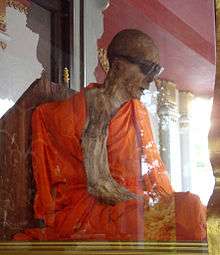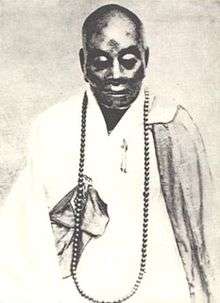Sokushinbutsu
Sokushinbutsu (即身仏) are a kind of Buddhist mummy. The term refers to the practice of Buddhist monks observing asceticism to the point of death and entering mummification while alive.[1] They are seen in a number of Buddhist countries, but the Japanese term "sokushinbutsu" is generally used.

It is believed that many hundreds of monks tried, but only 24 such mummifications have been discovered to date. There is a common suggestion that Shingon school founder Kukai brought this practice from Tang China as part of secret tantric practices he learned, and that were later lost in China.[2]
Origin
There is the existence of at least one "self-mummified" 550-year-old corpse: that of a Buddhist monk named Sangha Tenzin in a northern Himalayan region of India, visible in a temple in Gue village, Spiti, Himachal Pradesh.[3] This mummy was rediscovered in 1975 when the old stupa preserving it collapsed and it is estimated to be from about the 14th century, well after Islamic rule had arrived in India and Buddhism had practically vanished there. The monk was likely a Tibetan dzogpa-chenpo practitioner and similar mummies have been found in Tibet and East Asia.[4] The preservation of the mummy for at least 5 centuries was possible due to the aridity of the area and cold weather.[3]
According to Paul Williams, the Sokushinbutsu ascetic practices of Shugendō were likely inspired by Kūkai – the founder of Shingon Buddhism,[5] who ended his life by reducing and then stopping intake of food and water, while continuing to meditate and chant Buddhist mantras. Ascetic self-mummification practices are also recorded in China, but are associated with the Ch'an (Zen Buddhism) tradition there.[5] Alternate ascetic practices similar to Sokushinbutsu are also known, such as public self-immolation (auto cremation) practice in China, such as that of Fayu Temple in 396 CE and many more in the centuries that followed.[6] This was considered as evidence of a renunciant bodhisattva.[7]
Japan
A mountain-dwelling version of Buddhism called Shugendō emerged in Japan as a syncretism between Vajrayana, Shinto and Taoism in the 7th century, which stressed ascetic practices.[8] This tradition continued through the Edo period. One of its ascetic practice was Sokushinbutsu (or Sokushin jobutsu), connoting mountain austerities in order to attain Buddha-nature in one's body. This practice was perfected over a period of time, particularly in the Three Mountains of Dewa region of Japan, that is the Haguro, Gassan and Yudono mountains.[8] These mountains remain sacred in the Shugendō tradition to this day, and ascetic austerities continue to be performed in the valleys and mountain range in this area.[8][9]
In medieval Japan, this tradition developed a process for Sokushinbutsu, which a monk completed over about 3,000 days to ten years.[8] It involved a strict diet called mokujikigyo (literally, "eating a tree").[10][9] The diet abstained from any cereals, and relied on pine needles, resins and seeds found in the mountains, which would eliminate all fat in the body.[10][3] Increasing rates of fasting and meditation would lead to starvation. The monks would slowly reduce then stop liquid intake, thus dehydrating the body and shrinking all organs.[10] The monks would die in a state of jhana (meditation) while chanting the nenbutsu (a mantra about Buddha), and their body would become naturally preserved as a mummy with skin and teeth intact without decay and without the need of any artificial preservatives.[10][3] Many Buddhist Sokushinbutsu mummies have been found in northern Japan and estimated to be centuries old, while texts suggest that hundreds of these cases are buried in the stupas and mountains of Japan.[9] These mummies have been revered and venerated by the laypeople of Buddhism.[9]
One of the altars in the Honmyō-ji temple of Yamagata prefecture continues to preserve one of the oldest mummies – that of the sokushinbutsu ascetic named Honmyōkai.[11] This process of self-mummification was mainly practiced in Yamagata in Northern Japan between the 11th and 19th century, by members of the Japanese Vajrayana school of Buddhism called Shingon ("True Word"). The practitioners of sokushinbutsu did not view this practice as an act of suicide, but rather as a form of further enlightenment.[12]
Emperor Meiji banned this practice in 1879 and assisted suicide—including religious suicide—is now illegal.
In popular culture
The practice was satirized in the story "The Destiny That Spanned Two Lifetimes" by Ueda Akinari, in which such a monk was found centuries later and resuscitated. The story appears in the collection Harusame Monogatari.[13]
The practice is also extensively referenced in Japanese author Murakami Aruki's 2017 novel Killing Commendatore.
In Rumiko Takahashi’s series InuYasha, a priest named Hakushin was a “living mummy” who sacrificed himself via sokushinbutsu to save the people he served.
In the video game The Legend of Zelda: Breath of the Wild, the monks in the Ancient Shrines seem to be based on sokushinbutsu.[14]
See also
- Buddhist mummies
- Immured anchorite
- Luang Pho Daeng: A 20th-century monk mummy in Thailand
- Prayopavesa: A parallel practice in Hinduism
- Rainbow body
- Sallekhana: A parallel practice in Jainism
- Suicide in Japan
- Embalming
- Plastination
References
- Jeremiah, Ken. Living Buddhas: The Self-mummified Monks of Yamagata, Japan. McFarland, 2010
- Aaron Lowe (2005). "Shingon Priests and Self-Mummification" (PDF). Agora Journal. Archived from the original (PDF) on 2013-08-29. Retrieved 2012-12-14.
- A 500 year old Mummy with teeth, BBC News
- Ken Jeremiah (2010), Living Buddhas: The Self-mummified Monks of Yamagata, Japan, McFarland, pages 36–37
- Paul Williams (2005). Buddhism: Buddhism in China, East Asia, and Japan. Routledge. pp. 362 with footnote 37. ISBN 978-0-415-33234-7.
- James A. Benn (2007). Burning for the Buddha: Self-Immolation in Chinese Buddhism. University of Hawaii Press. pp. 33–34, 82–84. ISBN 978-0-8248-2992-6.
- James A. Benn (2007). Burning for the Buddha: Self-Immolation in Chinese Buddhism. University of Hawaii Press. pp. 112–114. ISBN 978-0-8248-2992-6.
- Ken Jeremiah (2010), Living Buddhas: The Self-mummified Monks of Yamagata, Japan. McFarland, pages 10–11
- Tullio Federico Lobetti (2013). Ascetic Practices in Japanese Religion. Routledge. pp. 130–136. ISBN 978-1-134-47273-4.
- Ken Jeremiah (2010), Living Buddhas: The Self-mummified Monks of Yamagata, Japan, McFarland, pages 11–14
- Tullio Federico Lobetti (2013). Ascetic Practices in Japanese Religion. Routledge. pp. 132–133. ISBN 978-1-134-47273-4.
- "Sokushinbutsu – Japanese Mummies". JapanReference.com. Retrieved 2013-09-30.
- Paul Gordon Schalow, Janet A. Walker The Woman's Hand: Gender and Theory in Japanese Women's Writing 1996, p. 174. "Most likely, Akinari's principal source for "The Destiny That Spanned Two Lifetimes" was "Sanshu amagane no koto" (About the rain bell of Sanshu [Sanuki province]), from Kingyoku neji-bukusa (The golden gemmed twisted wrapper; 1704)."
- "What are the Shrine Mummies in Zelda: Breath of the Wild?". Japan Powered. 2017-04-23. Retrieved 2020-02-18.
Further reading
- Hori, Ichiro (1962). "Self-Mummified Buddhas in Japan. An Aspect of the Shugen-Dô ("Mountain Asceticism") Sect". History of Religions. 1 (2): 222–242. doi:10.1086/462445. ISSN 0018-2710. JSTOR 1062053.
- Hijikata, M. (1996). Nihon no Miira Butsu wo Tazunete. [Visiting Japanese Buddhist Mummies]. Tokyo: Shinbunsha.
- Jeremiah, K. (2009). Corpses: Tales from the crypt. Kansai Time Out, 387, 8-10.
- Jeremiah, Ken (2007). "Asceticism and the Pursuit of Death by Warriors and Monks". Journal of Asian Martial Arts. 16 (2): 18–33.
- Matsumoto, A. (2002). Nihon no Miira Butsu. [Japanese Buddhist Mummies]. Tokyo: Rokkō Shuppan.
- Raveri, M. (1992). Il corpo e il paradiso: Le tentazioni estreme dell’ascesi. [The Body and Paradise: Extreme Practices of Ascetics]. Venice, Italy: Saggi Marsilio Editori.
- The Japanese Art of Self-Preservation Erika Nesvold 30 November 2015
External links
- Daruma Forums – photos and descriptions of travelling to see Sokushinbutsu
- http://sites.google.com/site/selfmummifiedmonks/ – Pictures of self-mummified monks.
- Dunning, Brian (4 November 2008). "Skeptoid #126: The Incorruptibles". Skeptoid. Retrieved 22 June 2017.
